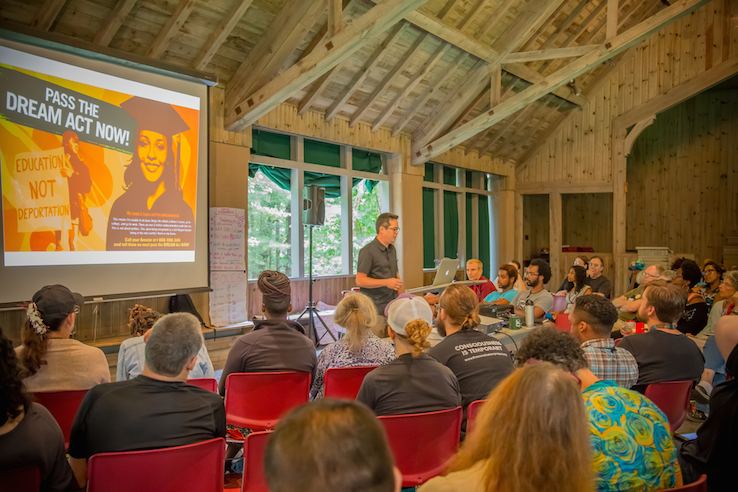L-R: Carlton Turner and Sistufara Muhammad lead a community dialogue at ROOTS Week 2015. Photo: Melisa Cardona.
Article by Jessica Solomon (Washington D.C.); Photos by Melisa Cardona (New Orleans, LA)
December 7, 2015
As I reflect on this year at Alternate ROOTS and look forward to 2016 – our 40th anniversary – I’m reminded of the Adinkra symbol “Sankofa” – to learn from our past. As a member of ROOTS, I am grateful for the ability to access much of our past, through oral traditions, apprenticeship and our growing digital archives.
You may recall, we are rounding out the second year of our “Call to Action” – a three-year initiative to investigate our work as artists and cultural organizers. Each year we go deep into a core element of arts activism: it was Aesthetics in 2014, Transformation this year, and Emergent Organizing in 2016. These themes are activated in a variety of ways – in our Partners in Action Program, ROOTS Week/ROOTS Weekends, and through the rich tapestry of arts activism that our members create in their communities across the country.
In physics, transformation is defined as the induced or spontaneous change of one element into another by a nuclear process. Transformation isn’t a new idea at ROOTS. As resources for social change, it is one of our guiding principals. This year, Transformation is the lens through which we’ve convened, resourced and documented our work and that of our members. This perspective required a deeper look into the way we navigate personal, institutional, systemic, social, and cultural change.
As a nation approaching the 2016 presidential election, we reel from terrorist attacks at home and abroad, we clash over welcoming refugees, we witness #BlackLivesMatter and student activism rise, and we feel the effects of climate change. Much like physics, we know the world we live in is full of both “induced and spontaneous” change that impacts us on multiple levels.
In spite of the socio-political climate, Alternate ROOTS has consistently contributed to the field through values driven dialogue, cultural exchange, and influencing cultural policy.
A few highlights in 2015 include:
- Carlton Turner, Executive Director of Alternate ROOTS, delivered the opening remarks at the Grantmakers In the Arts Racial Equity Forum, a national dialogue for arts funders on increasing funding and access for African, Latina/o, Asian, Arab and Native American organizations.
- The 39th Annual ROOTS Week (the largest to date) featured stirring visual art, dynamic performances and keynotes in response to environmental justice, #BlackLivesMatter and cultural equity, and im/migration by Colette Pichon Battle, Emery Wright and Jeff Chang, respectively. You can read reflections from members Nicole Garneau, Tamiko Ambrose Murray, Liana Ambrose-Murray, & Logan “John Soultrane” Murray, and Anu Yadav.
- We held the first of six ROOTS Weekends leading into our 40th year, in New Orleans, which you can read about in this article by Rebecca Mwase. And plans are underway for our January gathering in Eatonville, FL, in partnership with the Zora Neale Hurston Festival.
- The Artability Campaign raised enough money to provide ROOTS Week scholarships to three differently abled artists.
- ROOTS continued to provide technical and financial support to our members through our Artistic Assistance and Partners in Action Program. Total funds distributed amounted to $265,500.
- And we witnessed a plethora of member driven initiatives across the South.
As a member of the Executive Committee, the body tasked with setting organizational priorities, this Call to Action has demanded that we create space for reflection to acknowledge the ways our work in the South is impacting shifts in philanthropy and social practice across the country.
And again, I think of Sankofa. There’s no doubt that the visions voiced during ROOTS’ fledgling days prepare us for flight today.
On the heels of our 40th anniversary, and the end of the call to action, I’m imagining the ways ROOTS will impact the world 40 years from now. I feel the tension between history and holding space for what doesn’t yet exist. I wonder, “what is it that we are transforming into?”
Many of us are beginning the process of taking stock, reviewing our year, and imagining what doesn’t yet exist. Here are some tips I’ve gleaned from ROOTS’ year of Transformation that I think are applicable on an individual level:
#1: Show gratitude for what is.
#2: Acknowledge achievements, challenges and expand your notions of possibility.
#3: Tune in to opportunities.
#4: Be in action – show up and follow up.
In practice, Transformation at ROOTS is about forward movement, a greater sense of equity and justice in our relationships, skills and understandings for planning/implementing projects/actions using the arts, and vision for long-term solutions. Alternate ROOTS is becoming a more robust resource for our members. We are telling our story/stories. We are building bridges between emerging practitioners and our elders. We are the bastions of cultural equity in the field. We are fighting for immigrant rights, environmental justice and continuing the work of uprooting racism, patriarchy, homophobia and transphobia, internally and in the world. This year’s call to action has shown me that change is hard, scary work; and ROOTS is striving to create a safer environment and provide support for the process.
…..
 Jess Solomon is an organization development practitioner, strategist, facilitator, and design thinker. Jess serves on the Executive Committee of Alternate ROOTS, and is the Chief Weaver of Social Fabric at the U.S. Department of Arts & Culture.
Jess Solomon is an organization development practitioner, strategist, facilitator, and design thinker. Jess serves on the Executive Committee of Alternate ROOTS, and is the Chief Weaver of Social Fabric at the U.S. Department of Arts & Culture.



